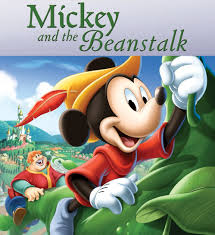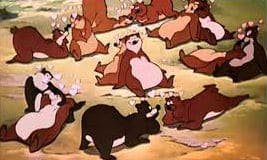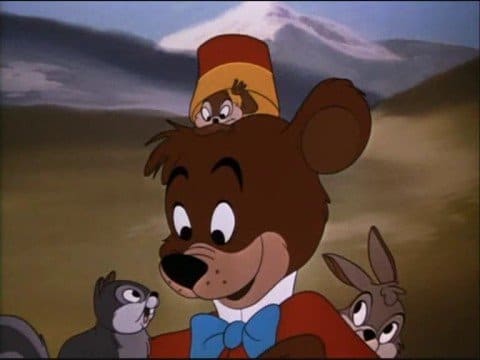
Welcome to Revisiting Disney! Today, we’re looking at the second of the anthology movies that were made after World War II, Fun and Fancy Free! Like last time, the next few films are collections of shorts, the format is a little different (I’ve moved the Plot and Source Material to the Animation section, similar to Fantasia).
Of course, I have labeled each category so if you want to skip to the parts that interest you most, feel free. And, of course, if you have any thoughts, burning or otherwise, please share in the comments!
BACKGROUND

Photo: Disney
Fun and Fancy Free was released on September 27th, 1947 and is also referred to as Fun and Fancy Free: Featuring Mickey and the Beanstalk. When people talk about this particular package film, “Mickey and the Beanstalk” is the one people think of. However, this film also includes another short, “Bongo.”
According to the “Making Of” feature at the end of the VHS, both shorts were actually in the works during the early 1940s but were shelved during the War. Not only did the Studio lose many members of their staff to the draft during the War and the Studio’s strike, Walt and his team spent the majority of the War years making training and propaganda shorts.
Walt Disney voiced Mickey Mouse in “Mickey and the Beanstalk.” It was the last time Walt would do so, passing the baton to Jim Macdonald. Most of Walt’s voice work was recorded in 1941 when the original work on the film was begun.
“Mickey and the Beanstalk,” as well as “Bongo,” were also supposed to be full-length animated features but, because the Studio was in such a financial bind, they began taking several shorts and weaving them together to form the package films.
Several of the shorts, these two and Ichabod and Mr. Toad, were made into package films with just two shorts because they are a tad longer, but not long enough to be their own films. This film is also unique in that it includes some of the most beloved Disney characters, Mickey Mouse, Donald Duck, Goofy and Jiminy Cricket. It’s also the first time that Mickey, Donald, and Goofy were the stars of a feature-length film.
Even though this is a film that has not been released often on video, like the rest of the package films the individual segments have been aired on television or released separately on home video.
MUSIC
The music of Fun and Fancy Free is really quite fun. Cliff Edwards reprised his role of Jiminy Cricket for speaking and singing both the opening number “I’m a Happy-Go-Lucky Fellow” and “Fun and Fancy Free.”
“Happy-Go-Lucky” was written by Ned Washington; who had worked on Pinocchio and Dumbo, and Eliot Daniel; who worked on Melody Time and Make Mine Music. Eliot Daniel also worked on the songs in “Bongo” with Buddy Kaye, who would compose the music for “I Dream of Jeannie,” among other things.
Dinah Shore narrates the story of “Bongo” and also sings the main part of every song in the piece. This gives the short a feel of continuity, especially when the main characters really don’t talk. The whole story is told through the bear’s facial expressions and Dinah Shore’s vocal inflections.
ANIMATION
The animation is really fun in this short. Many of the Nine Old Men were represented in the credits, and it shows. The backgrounds are beautifully drawn and the characters fit into their world in exciting ways.
The film opens with Jiminy Cricket singing “I’m a Happy-Go-Lucky Fellow,” a song that had been written originally for Pinocchio but cut due to timing. Jiminy travels through the animated house and dispenses advice, before winding up in a room with a sad doll and a sad bear. In an attempt to cheer them up, he finds a record of “Bongo” and begins to play it.
“Bongo” is based on a Sinclair Lewis story that was originally published in Cosmopolitan in 1930. The short is narrated by Dinah Shore and tells the story of a circus bear (Bongo) who wants to escape and run free. Of course, he does run away and falls in love with another bear.
According to the “Making Of” feature on the VHS, “Bongo” was going to be a full-length feature before the War and had been originally pitched as kind of sequel of Dumbo, using the same circus and some of the same supporting characters. This would have been really fun and something that probably got cut when the story was made into a short film.
RELATED: Revisiting Disney: Dumbo
The short is beautifully animated. I love the contrast between what Bongo expects the forest and his freedom to be versus what happens during his first night in the wild. It ends up being terrifying for him, and he goes through a time where it seems like he regrets his choice to run away in the first place.
Bongo’s time in the wild takes a turn for the better when he meets Lulabelle, a lovely lady bear who is clearly interested in him. They share a wonderful musical number that takes them through the forest and to the other bears. Unfortunately, Lulabelle has another suitor, a big gruff bear who immediately hates Bongo. When Lulabelle slaps Bongo to convey her love, he doesn’t understand what is happening and is brokenhearted. She accidentally slaps Bongo’s rival and he is thrilled.
When Bongo sees the other bears slapping each other and singing “A Bear Likes to Say it With a Slap,” he realizes what happened and races to his lady. Bongo then engages in a fight with his rival, which he wins. He and Lulabelle slap each other and, presumably, live happily ever after.

Photo: Disney
“Bongo” is a bit problematic to me, mostly because of the way that bears communicate their affection; in this tale, bears say that they love you to their significant others by slapping them. The idea of slapping your significant other makes me very uncomfortable.
Even though it’s a mutual slap, it seems like a foundation for an unhealthy relationship. I get that it was supposed to be funny, but to me, it wasn’t (and probably not too many other people today either). I understand why Bongo feels so broken-hearted.
“Mickey and the Beanstalk,” like I mentioned earlier, had been in production much earlier, beginning in 1940. Originally, Sterling Holloway was going to be the narrator, but when they combined the two shorts they added in some human talent.
The frame story for “Mickey and the Beanstalk” can be seen as kind of creepy; it’s a little girl, an adult and two dummies; but it actually made the whole film more recognizable to the audience because of who was cast.
The frame story is a party attended by child star Luana Patten and Edgar Bergen. Edgar Bergen was a famous ventriloquist who had a radio show, and with him at this party is Charlie McCarthy and Mortimer Snerd (two famous dummies). The combination of these four well-known figures adds to the star power that has already been established by the combination of Mickey, Donald, Goofy and Jiminy Cricket.
As the story unfolds, the characters interrupt Bergen with funny insights and questions. According to two of my favorite film historians, Thomas and Finch, although the intent had been to reestablish Mickey Mouse as a star, Donald and Goofy stole the show. As in the Disney shorts, these two characters had become fan favorites.
![By The Walt Disney Company (Trailer) [Public domain], via Youtube](https://www.silverpetticoatreview.com/wp-content/uploads/2015/08/donald-duck-300x167.jpg)
The story opens in the magical land of Happy Valley, where a magic harp casts a spell of happiness with her voice over the valley. This causes the crops to grow and everything to flourish. Sadly, the Magic Harp is kidnapped one night and sadness descends on the valley.
In this time of sadness, we meet our heroes, Mickey, Donald and Goofy and their cow, Bossy. They are starving and trying to survive (their crops have all died). Donald, of course, is the first to go crazy and tries to kill the cow. Mickey plays the Jack character and sells Bossy for some magic beans. Donald is, of course, not amused.
The beans are magic, however, and a beanstalk grows, taking the three to a giant castle. Inside the castle, they find the kidnapped magic harp, a ton of food and a giant/ogre who can change his shape.
The story continues on in the typical “Jack and the Beanstalk” fashion, with the giant chasing after our heroes when they save the magic harp. It ends with our three farmers cutting down the beanstalk and the giant falling to what we thought was his death.
As it turns out, the giant survived and began traveling the world, looking for the talking mouse that tried to kill him and stole the magic harp from him. This is a really fun twist, and the reaction that the live action cast has to his appearance is quite delightful.
There are two bits of animation that I want to highlight. The first one is when the beanstalk grows up in the night, destroying the house where Mickey, Donald and Goofy live and carrying them up to the giant’s castle. The combination of the music and the beanstalk growing with its own personality makes this a fun sequence that builds beautifully to the reveal of the kingdom in the clouds.
The second bit that I love is when Donald Duck goes crazy and tries to kill Bossy the Cow because he’s so hungry. It’s a kind of traumatic scene, but one that is really well drawn. You feel the emotions of all the characters involved, and even Donald’s crazy rambling makes sense.
The 1940’s
As I said last week, since the other two compilation films, or package films, had done so well (Saludos Amigos and The Three Caballeros were popular in their day), this was a way for the Studio a way to continue making quality product with limited resources and limited manpower.
RELATED: Revisiting Disney: Make Mine Music
Bob Thomas calls the films from this era “the anthology features” and says that “the company was deeply in debt. Unable to finance a new feature like Snow White or Pinocchio, Disney launched a series of economical films that brought little glory but much-needed income to the studio” (Thomas 1992:99). Basically, Disney was trying to make money to keep afloat and the result is a series of films that still seem to be seriously underrated.
In the late 1940s, the country was in a bit of a funk. In a lot of ways, the anthology films served as a way to provide a sense of fun (and fancy free) to a country that has discovered atomic power and just been involved in a major war. This film, according to the “Making Of” special, was a welcome film to the filmgoing world, a lighthearted story filled with many of the world’s most beloved characters; it was a story that was what people had wanted from Disney and were excited to get.
LESSONS LEARNED
From Fun and Fancy Free, the main lesson, to me, is that the key to living a happy life is to not worry and to be happy. The opening song sung by Jiminy Cricket says “don’t cross a bridge or peak ‘round a corner until you’re there,” and that fits the overall mood of the 40s; this is something that would appeal to the people in this era of worry.
This film also emphasizes to me the importance of song. The magic harp casts her spell of joy through song, Jiminy Cricket conveys his joy through song and Dinah Shore tells the story of love and misunderstanding through song. Music can be seen as a way to convey complex emotions and to help people work through those emotions.

From “Bongo,” a lesson that can be learned is that it’s important to learn about other cultures when you’re trying to participate in that culture. Bongo doesn’t know that bears convey love and affection through physical violence, so when Lulabelle slaps him he is confused. If he had known that this was how bears communicated, a lot of the conflict would have been resolved.
DOES IT HOLD UP?
When you look at the shorts, I would say that “Mickey and the Beanstalk” holds up better than “Bongo” or the frame story. Without knowing who the stars are or that the studio was trying to build their resources up again after the War and the Strike, the middle sections can seem disjointed and out of place.
Overall, however, this is a really fun film and even if I found “Bongo” to be a bit disappointing and the frame story to be less compelling, it was well worth the time it takes to watch. Fun and Fancy Free is truly a fun romp with some of the most beloved characters Disney has ever had and a star-studded human cast as well.
For next week: Melody Time
If you enjoyed this post and the others in the Revisiting Disney series, and have found yourself wishing that you could find them all in one convenient and bound book with eight extra essays, there is an option for you! Check out A Journey Through Disney: My Look Back Through Disney Canon, now available on Amazon as both a Kindle book ($4.99) and a paperback ($11.99).
OTHER SOURCES:
https://thewaltdisneycompany.com/about-disney/disney-history
http://www.imdb.com
http://studioservices.go.com/disneystudios/history.html
Bailey, Adrian. Walt Disney’s World of Fantasy. Everest House Publishers. New York, New York. 1982.
Dower, John W. War Without Mercy: Race and Power in the Pacific War. Pantheon Books. New York, New York. 1986.
Finch, Christopher. The Art of Walt Disney: From Mickey Mouse to the Magic Kingdom. Harry N. Abrams, Inc. New York, New York. 1975.
Sale, Roger. Fairy Tales and After: From Snow White to E.B. White. Harvard University Press. Cambridge, MA, 1978.
Tatar, Maria. The Annotated Classic Fairy Tales. W.W. Norton and Company. New York and London, 2002.
Thomas, Bob. Disney’s Art of Animation From Mickey Mouse to Hercules. Hyperion. New York, New York. 1992.
Wright, Gordon. The Ordeal of Total War: 1939-1945. Harper Torchbooks, Harper & Row. New York, Hagerstown, San Francisco, and London, 1968.
ARE YOU A ROMANCE FAN? FOLLOW THE SILVER PETTICOAT REVIEW:
 Our romance-themed entertainment site is on a mission to help you find the best period dramas, romance movies, TV shows, and books. Other topics include Jane Austen, Classic Hollywood, TV Couples, Fairy Tales, Romantic Living, Romanticism, and more. We’re damsels not in distress fighting for the all-new optimistic Romantic Revolution. Join us and subscribe. For more information, see our About, Old-Fashioned Romance 101, Modern Romanticism 101, and Romantic Living 101.
Our romance-themed entertainment site is on a mission to help you find the best period dramas, romance movies, TV shows, and books. Other topics include Jane Austen, Classic Hollywood, TV Couples, Fairy Tales, Romantic Living, Romanticism, and more. We’re damsels not in distress fighting for the all-new optimistic Romantic Revolution. Join us and subscribe. For more information, see our About, Old-Fashioned Romance 101, Modern Romanticism 101, and Romantic Living 101.

Comments are closed.